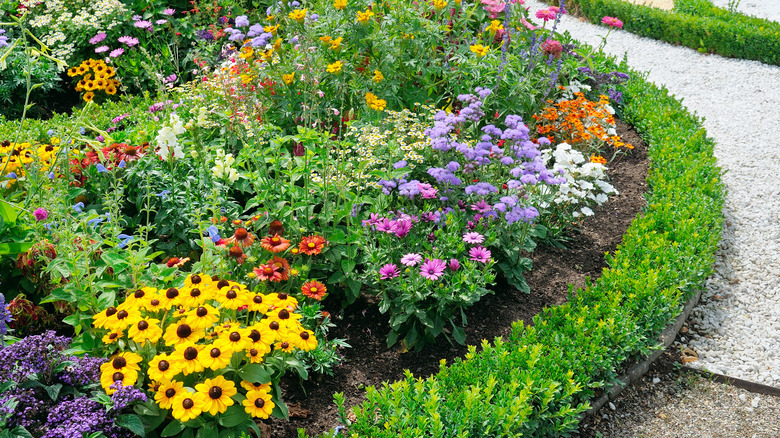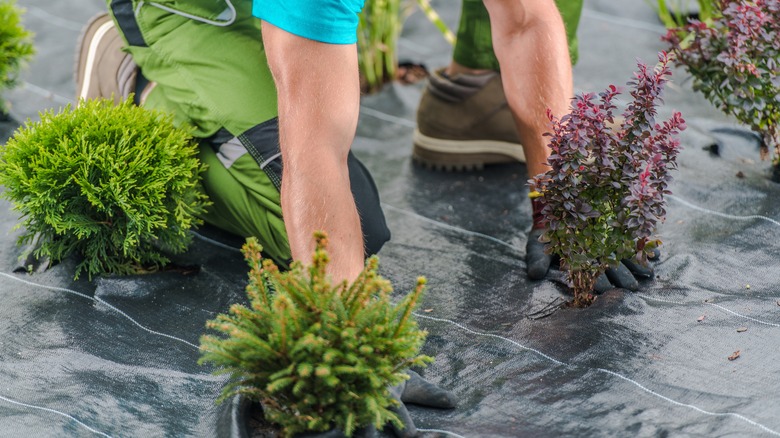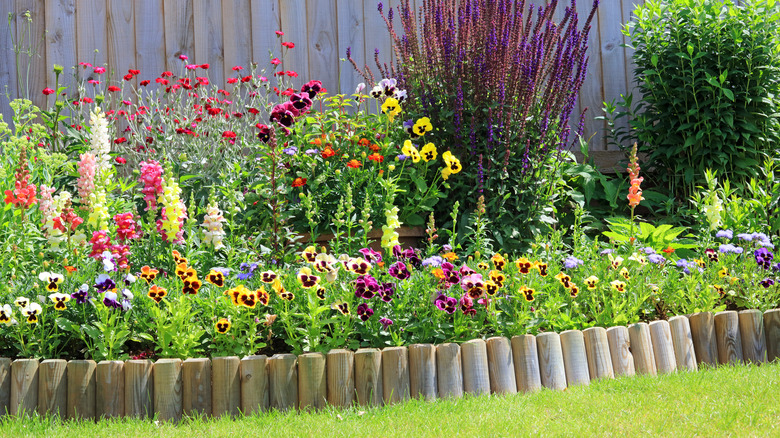You Don't Have To Forsake Your Plants To Stop Grass From Growing In Your Flower Beds
Bright green blades of grass popping up from under a melting pile of snow at the end of winter is usually a welcoming sight. But grass popping up between plantings in your flower bed is another story. If you've got time to kill and enough physical dexterity, you could pull out the blades by hand. It's free to do, yet time-consuming and temporary. To make a serious dent in the future growth of the grass, you'd need to think of it like a weed and pull each blade out completely, roots and all. That's pretty difficult to accomplish; ultimately, you'll just be breaking them off, which sets them up to grow quickly.
You could turn to herbicides and other potentially toxic chemicals that effectively kill all weeds and pesky grass for a longer-term solution. The obvious downside is that those sprays harm any plant they come into contact with, meaning your flowers will suffer, too. Don't give up yet, though! You have two more options that we'll explore below, neither of which require back-breaking weeding or noxious chemicals. First, you can rely on a cover product like mulch or landscape fabric to impede grass from poking out above the topsoil. Second, you can isolate the flower bed area with some edging.
Mulch and landscape fabric
Gardening mulch is a widespread solution to a long list of gardening woes, so it should come as no surprise that it's recommended to keep grass at bay. Just as it does for weeds, a layer of mulch prohibits grass seedlings from receiving sunlight, thus hindering their existence. Depending on the type you choose, you may have to replace the mulch every year. So that becomes a spring chore to add to your list and an expense line for your budget.
Landscape fabric creates a barrier that inhibits any growth beneath it but still allows water to make its way down into the soil through gaps in woven fabric or via perforated holes in a solid sheet. Landscapers often cover it with gravel to keep it from sliding around; you can also hammer in large U-shaped wire pins that poke through the fabric. You may find it labeled as landscape cloth or weed-garden fabric at the store or online. It's all basically the same product though some options will be thicker than others. Landscape fabric should last longer than mulch, but before you decide this is the end-all answer to your unwanted grass problem, note that it needs to be installed before any plants go in the ground, and you'll need to cut holes in the fabric wherever you want to plant flowers. Each of those cuts provides a path back to the surface for the grass.
Edging
Edging is an effective deterrent against stray patches of grass, and it comes in enough different materials and styles that your biggest problem will be deciding on one. Clay, bricks, concrete, metal, wood, plastic, and stone can all be used to create a border. Edging will be the more expensive option for grass management, but it'll also be a more stylish way to elevate the presentation of your flowers. Whichever type you install, it will perform the same function as the others by creating a definitive boundary between your lawn and your flower bed.
One downside to edging is that the more advanced you get with its design, the farther away from the easy weekend project the installation becomes. Custom-cut steel or heavy stone borders will require professional landscapers. To keep it simple, consider the plastic type with spikes you'll drive into the ground as you set it into place or rolls of flexible metal that will allow you to curve it around corners for a fluid look. For real-deal DIYers, why not cut wooden edging in your own design? Keep the pieces even and squared off, or try slicing round logs lengthwise and cutting pieces to create staggered heights throughout the border for a rustic appeal. Pressure-treated wood will protect the soil beds from fungi and rot. And, of course, this is a material you can paint for additional decorative effects.


